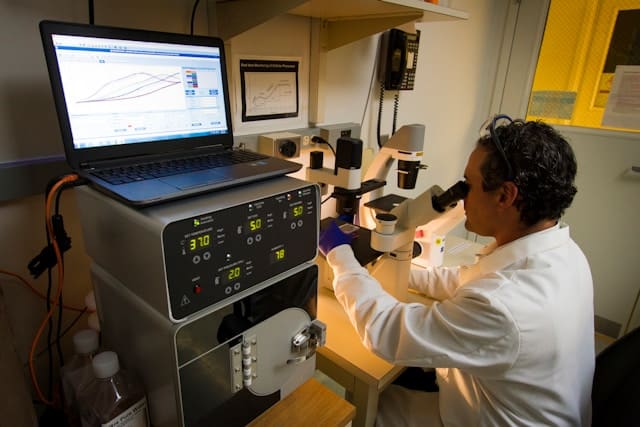Nanomedicine is an innovative field that combines nanotechnology with medicine to develop novel therapeutic approaches. This field has shown significant potential in diagnosing, treating, and preventing various diseases, including cancer. In recent years, advances in nanotechnology have led to the development of novel nanocarriers such as liposomes, nanoparticles, and nanocrystals that can deliver anti-cancer drugs directly to tumor cells. This article delves into the latest developments in nanomedicine for cancer treatment, focusing on nanocarriers and their clinical implications.
The Role of Nanocarriers in Cancer Treatment
Nanocarriers are minute particles that can carry therapeutic drugs to specific sites within the body. When used in cancer treatment, these particles can be engineered to selectively target tumor cells, thereby enhancing the drug’s efficacy and reducing side effects.
Sujet a lire : Luxury real estate in beaulieu-sur-mer: find elegance
Liposomes in Cancer Therapy
A significant proportion of the nanomedicine in cancer treatment field revolves around liposomes – microscopic lipid vesicles capable of carrying drugs to precise locations in the body. Liposomes have been at the forefront of nanomedicine due to their biocompatibility and ability to encapsulate both hydrophilic and hydrophobic drugs.
Liposomes can deliver a variety of drugs, such as doxorubicin, a potent anti-cancer drug commonly used to treat different types of cancers. The liposome encapsulation allows for the drug’s safe passage through the body and ensures its delivery directly to the tumor cells. This targeted approach increases the drug’s effectiveness while minimizing its toxic effects on healthy tissues.
A voir aussi : Shimmer in style: your guide to the best sequin jackets
Clinical trials are being conducted to evaluate the safety and efficacy of liposomal doxorubicin treatment. The National Clinical Trial (NCT) site provides updates on the status of these trials, offering an insight into the progress and potential applications of liposomal doxorubicin in cancer treatment.
Nanoparticles and Cancer Therapy
Another critical development in the field of nanomedicine for cancer treatment is the use of nanoparticles (NPs). These minute particles can be engineered to deliver drugs, genes, or proteins directly to tumor cells, allowing for targeted, high-efficacy treatments.
Nanoparticles for Drug Delivery
Nanoparticles have revolutionized drug delivery in cancer treatment. Their small size allows them to penetrate tumors and deliver drugs to cancer cells more effectively than conventional drug delivery methods.
For instance, nanoparticles encapsulating doxorubicin have been developed to target and kill breast cancer cells. These NPs can evade the immune system, accumulate in tumor tissues, and release the drug in a controlled manner. This targeted approach reduces the systemic toxicity associated with doxorubicin treatment, improving patient outcomes.
Nanoparticles for DNA Delivery
Nanoparticles can also be used to deliver DNA to cells. This approach, known as gene therapy, has shown promise in treating various types of cancer. NPs can carry therapeutic DNA directly to tumor cells, altering their genetic material and inhibiting their growth.
One example is the use of lipid nanoparticles to deliver mRNA vaccines, a technology that gained spotlight during the COVID-19 pandemic. This same technology is now being explored to develop mRNA-based cancer vaccines, marking a promising advancement in the field of cancer therapy.
Acid-Triggered Drug Delivery Using Nanoparticles
A recent breakthrough in the field of nanomedicine for cancer treatment involves the use of acid-triggered drug delivery. Tumors often have an acidic microenvironment, which can be exploited for targeted drug delivery using pH-sensitive nanoparticles.
These nanoparticles are designed to remain stable at the body’s normal pH but to disintegrate when they encounter the acidic environment of a tumor. This leads to the release of the encapsulated drug directly at the tumor site, ensuring targeted and effective treatment.
Moreover, from a clinical perspective, this technology could potentially lead to the design of more efficient and less toxic cancer treatments, as it ensures that drugs are delivered only to cancer cells, sparing healthy cells from exposure.
Nanomedicine: Boosting the Immune Response to Cancer
Nanomedicine does not only rely on the delivery of anti-cancer drugs. It also encompasses strategies to stimulate the body’s immune response against cancer. By using nanoparticles to deliver immune-stimulating agents to tumor sites, it’s possible to train the immune system to recognize and attack cancer cells, similar to how it would combat pathogens.
For instance, some nanoparticles are designed to deliver immune checkpoint inhibitors, drugs that boost the immune response against cancer. These NPs are usually decorated with molecules that attract immune cells, leading to an enhanced immune response at the tumor site.
While the clinical application of these immune-boosting nanoparticles is still under investigation, early results from laboratory and animal studies are promising, suggesting that this approach could be a game-changer in cancer immunotherapy.
In conclusion, nanomedicine offers new opportunities for cancer treatment, thanks to advancements in nanocarriers and nanoparticle technology. These innovative treatments promise more targeted, efficient, and less toxic options for cancer patients. As research progresses and new treatment strategies emerge, a future where cancer is a manageable disease, as opposed to a deadly one, seems increasingly possible.
The Role of Polymeric Nanoparticles in Cancer Therapy
Polymeric nanoparticles, another type of nanocarrier, have recently emerged as a promising tool for cancer treatment. These are tiny particles composed of polymers, which can be designed to encapsulate a variety of chemotherapeutic drugs for targeted drug delivery.
Polymeric Nanoparticles for Active Targeting
Polymeric nanoparticles can be engineered for "active targeting". This means they can be decorated with specific molecules that bind selectively to receptors overexpressed on cancer cells. This allows the nanoparticles to recognize and bind to tumor cells, ensuring the delivery of the chemotherapeutic drugs specifically to the tumor site while sparing healthy cells.
One example is the use of polymeric nanoparticles decorated with molecules that bind to HER2, a receptor overexpressed in some types of breast cancer. In clinical trials, these nanoparticles have shown promise in delivering anti-cancer drugs specifically to HER2-positive breast cancer cells, improving the efficacy of the treatment and reducing side effects.
Overcoming Multidrug Resistance with Polymeric Nanoparticles
Multidrug resistance is a significant obstacle in cancer therapy. It occurs when cancer cells become resistant to multiple chemotherapeutic drugs, hindering their effectiveness. Polymeric nanoparticles offer a potential solution to this problem.
By encapsulating multiple drugs within a single nanoparticle, it is possible to deliver a combination of drugs to tumor cells. This can overwhelm the cancer cells’ resistance mechanisms, making the treatment more effective. Furthermore, the controlled drug release feature of polymeric nanoparticles can maintain a constant therapeutic level of drugs in the body, further improving treatment efficacy.
The Future of Nanomedicine in Cancer Treatment: Looking Ahead
The field of nanomedicine is rapidly evolving, bringing new hope for cancer patients. The latest developments in nanocarriers, such as liposomes, nanoparticles, and polymeric nanoparticles, hold great promise for the future of cancer therapy.
Personalized Nanomedicine
The future of nanomedicine could lie in personalized treatment strategies. With the ability to engineer nanoparticles to target specific types of cancer cells, it’s conceivable that treatments could be tailored to individual patients based on the specific characteristics of their tumors.
This approach could significantly increase the effectiveness of treatment, reduce side effects, and improve patient outcomes. Several clinical trials are currently underway to explore this potential, with results eagerly awaited by the medical community.
Increasing Circulation Time
One of the challenges currently faced by nanomedicine is the relatively short circulation time of nanoparticles in the body. However, researchers are working on new designs that can increase the time nanoparticles remain in the bloodstream. This could allow for more effective delivery of drugs to tumor sites, further enhancing the effectiveness of nanomedicine.
To stay updated on the latest in this dynamic field, resources like Google Scholar provide ongoing access to new research and clinical trials. Platforms like the National Clinical Trial (NCT) site provide regular updates on the progress of clinical trials in nanomedicine.
In conclusion, the advancements in nanomedicine are bringing about a paradigm shift in cancer therapy. Focused drug delivery, immune system modulation, overcoming multidrug resistance, and the possibility of personalized treatments are all promising avenues being explored. As research progresses, the hope is that these innovative approaches will make cancer a manageable disease, reducing its present status as a major cause of death worldwide.















